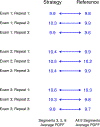Repeatability and accuracy of various region-of-interest sampling strategies for hepatic MRI proton density fat fraction quantification
- PMID: 33609166
- PMCID: PMC8983333
- DOI: 10.1007/s00261-021-02965-5
Repeatability and accuracy of various region-of-interest sampling strategies for hepatic MRI proton density fat fraction quantification
Abstract
Purpose: To evaluate repeatability of ROI-sampling strategies for quantifying hepatic proton density fat fraction (PDFF) and to assess error relative to the 9-ROI PDFF.
Methods: This was a secondary analysis in subjects with known or suspected nonalcoholic fatty liver disease who underwent MRI for magnitude-based hepatic PDFF quantification. Each subject underwent three exams, each including three acquisitions (nine acquisitions total). An ROI was placed in each hepatic segment on the first acquisition of the first exam and propagated to other acquisitions. PDFF was calculated for each of 511 sampling strategies using every combination of 1, 2, …, all 9 ROIs. Intra- and inter-exam intra-class correlation coefficients (ICCs) and repeatability coefficients (RCs) were estimated for each sampling strategy. Mean absolute error (MAE) was estimated relative to the 9-ROI PDFF. Strategies that sampled both lobes evenly ("balanced") were compared with those that did not ("unbalanced") using two-sample t tests.
Results: The 29 enrolled subjects (23 male, mean age 24 years) had mean 9-ROI PDFF 11.8% (1.1-36.3%). With more ROIs, ICCs increased, RCs decreased, and MAE decreased. Of the 60 balanced strategies with 4 ROIs, all (100%) achieved inter- and intra-exam ICCs > 0.998, 55 (92%) achieved intra-exam RC < 1%, 50 (83%) achieved inter-exam RC < 1%, and all (100%) achieved MAE < 1%. Balanced sampling strategies had higher ICCs and lower RCs, and lower MAEs than unbalanced strategies in aggregate (p < 0.001 for comparisons between balanced vs. unbalanced strategies).
Conclusion: Repeatability improves and error diminishes with more ROIs. Balanced 4-ROI strategies provide high repeatability and low error.
Keywords: Hepatic PDFF; Hepatic fat quantification; QIB; Quantitative imaging biomarker; Region-of-interest; Repeatability; Sampling strategy.
Figures










References
Publication types
MeSH terms
Substances
Grants and funding
LinkOut - more resources
Full Text Sources
Other Literature Sources
Medical

